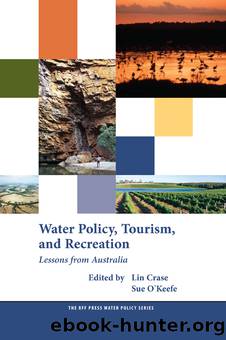Water Policy, Tourism, and Recreation by Crase Lin;O'Keefe Suzanne;

Author:Crase, Lin;O'Keefe, Suzanne;
Language: eng
Format: epub
ISBN: 1099276
Publisher: Earthscan LLC
PART III
PRACTICAL CHALLENGES AND POLICY FORMULATION
CHAPTER 8
The Swan River: Look but Do Not Touch
Fiona Haslam McKenzie
In many parts of the world, within the context of broader economic restructuring, urban river systems have been reinterpreted as resources of value for the purposes of recreation and tourism (Marzano et al. 2009). This is not the case in Perth. Almost every visitor here will, at some time during his or her visit, look at and admire the section of the Swan River in Perth that passes in front of the central business district (CBD), commonly referred to as Perth Water. It is more than likely, however, that this is all he or she will doâlook but not touch or really experience all that the Swan River has to offer in terms of its recreational potential, history, or heritage.
Compared with other Australian cities, such as Sydney, Melbourne, and Brisbane, tourism is âunderdoneâ in Perth. Approximately 3.5 million people visit Perth a year, and not surprisingly, international visitors stay the longest and spend the most while they are visiting (Tourism Western Australia 2009). Brisbane, by comparison, has a similar population, but about 5.5 million people visit each year and spend almost twice as much per capita (Tourism Queensland 2009). Melbourne has twice the population and, it can be argued, does not have proximity to superb natural assets such as both Brisbane and Perth have, but tourism is a very important industry for the city and Victoria more broadly. Neither the Yarra River in Melbourne nor the Brisbane River in Brisbane provides the open water vistas or recreational variety potentially available on the Swan River. Nonetheless, both cities aggressively pursue tourism opportunities in and around the city centers and the rivers that flow through them.
In examining the nexus between water and tourism, the Swan River makes a compelling and timely case study. First, the Swan River was named as Western Australiaâs first official heritage icon in 2002 by Premier Geoff Gallop. Second, more tourist hotels and services are concentrated in the CBD than anywhere else in Perth. Third, Perth Water is one of the largest stretches of water in the entire metropolitan river system. This research was conducted against the backdrop of considerable public debate about the lack of foreshore development at Perth, the characterization of Perth as âDullsvilleâ in the media, and community concern for the health of the Swan-Canning River system.
This chapter focuses on why, despite its potential, Perth Water remains an underdeveloped and undervalued tourism asset. It is argued in this chapter that development on the Swan River, particularly that related to tourism, is constrained by inertia and NIMBYism, which has broad economic and social implications.1 In contrast, this chapter also examines the process behind the recent revitalization of the Harlem River in New York City in an effort to derive lessons to assist decisionmakers in using Perth Water more presciently.
This chapter first presents the background and context, including the modern history of Perth Water, and reviews the current tourism opportunities. Issues relating
Download
This site does not store any files on its server. We only index and link to content provided by other sites. Please contact the content providers to delete copyright contents if any and email us, we'll remove relevant links or contents immediately.
| Automotive | Engineering |
| Transportation |
Whiskies Galore by Ian Buxton(41938)
Introduction to Aircraft Design (Cambridge Aerospace Series) by John P. Fielding(33093)
Small Unmanned Fixed-wing Aircraft Design by Andrew J. Keane Andras Sobester James P. Scanlan & András Sóbester & James P. Scanlan(32764)
Craft Beer for the Homebrewer by Michael Agnew(18197)
Turbulence by E. J. Noyes(7978)
The Complete Stick Figure Physics Tutorials by Allen Sarah(7338)
Kaplan MCAT General Chemistry Review by Kaplan(6900)
The Thirst by Nesbo Jo(6879)
Bad Blood by John Carreyrou(6583)
Modelling of Convective Heat and Mass Transfer in Rotating Flows by Igor V. Shevchuk(6406)
Learning SQL by Alan Beaulieu(6237)
Weapons of Math Destruction by Cathy O'Neil(6215)
Man-made Catastrophes and Risk Information Concealment by Dmitry Chernov & Didier Sornette(5956)
Digital Minimalism by Cal Newport;(5704)
Life 3.0: Being Human in the Age of Artificial Intelligence by Tegmark Max(5516)
iGen by Jean M. Twenge(5385)
Secrets of Antigravity Propulsion: Tesla, UFOs, and Classified Aerospace Technology by Ph.D. Paul A. Laviolette(5333)
Design of Trajectory Optimization Approach for Space Maneuver Vehicle Skip Entry Problems by Runqi Chai & Al Savvaris & Antonios Tsourdos & Senchun Chai(5037)
Pale Blue Dot by Carl Sagan(4954)
